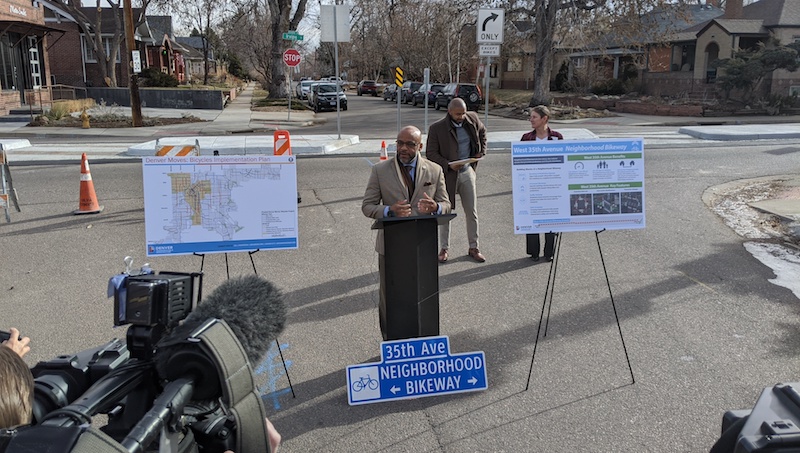
Denver’s Vision Zero plan aims for zero traffic-related deaths by 2030, but fatalities have increased every year since 2011 with the exception of 2017. A new dedicated bikeway in North Denver is one way the city is hoping to reverse that trend by creating a safer way for cyclists to cross from Sheridan to I-25.
New traffic calming measures that were intended to make the route friendlier to cyclists make it less convenient for cars. While neighbors and bike advocates are celebrating the new route, some neighbors are raising concerns that traffic circles and other traffic calming measures don’t actually slow traffic and may be making the streets less safe instead of more.
Mayor Hancock spoke at the unveiling of the new route in January after several of the concrete medians that stop car traffic from traveling east-west on West 35th Avenue were installed. “Vision Zero can’t just be a slogan,” Hancock said. “Our mobility system is going to provide multiple ways for people to get around.” City officials pledged 125 miles of new bike lanes by 2023.
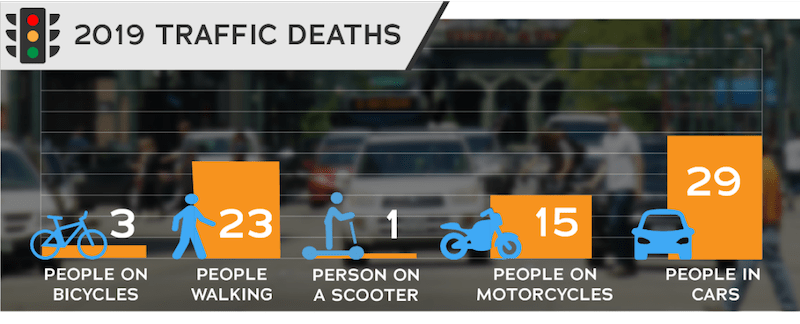
Bikeway Traffic Calming Efforts
In August 2018, the City and County of Denver installed three temporary neighborhood traffic circles along West 35th Avenue at the intersections of Julian, Newton and Raleigh streets. They were the first-ever traffic circles installed by the City and County of Denver (different than roundabouts primarily in the size of the intersection), and they were intended to calm traffic heading east and west along the corridor. People traveling north and south on Raleigh, Newton and Julian must come to full stop at the traffic circle before crossing West 35th Avenue.

The circles were part of the Denver Moves plans to convert West 35th Avenue into a neighborhood bikeway. The mostly-residential corridor is 2.6 miles long. It was already a designated bike route, and the upgraded bikeway status gives priority to non-motorized and bicycle traffic on the road.
The West 35th Avenue and other neighborhood bikeway plans are available at denvergov.org/neighborhoodbikeways. According to the website, the roadway design, signage and traffic calming measures of neighborhood bikeways are intended to emphasize multimodal travel, and discourage through traffic for motorized vehicles while preserving local access needs for residents.
“To maneuver around the circle, you need to slow down,” said City Traffic Engineer Emily Gloeckner. “And the reason we put them on a neighborhood bikeway is to slow vehicles down to a comfortable speed similar to cyclists.” She said the city wanted to pilot how well the traffic circles would reduce vehicle speeds.
The city conducted a before and after study about the effects of the traffic circles just one month after installation. The November 2018 report said “the traffic circles do not appear to have a large impact on vehicle speeds.”
“Based on the speed study and data we received to date, the circles haven’t slowed traffic down the way we need them to,” Gloeckner acknowledged. She said the city wants to conduct another speed study now that other traffic calming (like medians and signage) has been installed before making determinations about how to best modify the traffic circles before they are made permanent.
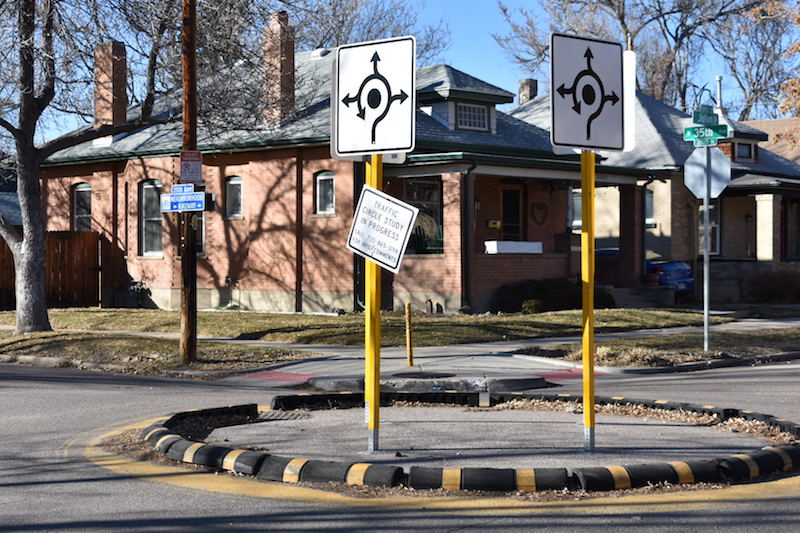
Department of Transportation & Infrastructure spokeswoman Nancy Kuhn said the low cost rubber curbs the circles were initially built with are temporary and will eventually be replaced with more permanent materials. The city will re-stripe the street in February, and will let traffic normalize after that before conducting a new speed study, likely in the spring. From there, they will gather additional community input before determining final design and treatments.
Controversy Around Circles, Calming and Cost
While most neighbors say they support the bikeway concept, they are divided about the various traffic calming measures, whether they actually have a traffic calming effect and how much they’ve cost taxpayers.
Grace Chrisholm moved to the neighborhood two years ago from Portland, and believes even the signage noting it’s a bikeway will help with car-cyclist-pedestrian problems. “Drivers are more careful if they know they’re on a bike route.” She said her husband commutes daily by bike and the improvements will make his ride safer.
Bill Conklin, who lives on Raleigh Street at West 32nd Avenue disagrees: “The traffic circles on 35th Avenue are very dangerous,” he said. “The intersection is not big enough and the cars don’t slow down. Some people don’t understand the situation and make left turns before the circle. Cars use the circle to make U-Turns and have come close to hitting pedestrians.”
In the five minutes The Denver North Star was taking photographs at the Raleigh traffic circle, one car turned left in front of the circle (the wrong way into oncoming traffic), a truck made a U-turn and couldn’t make the radius so pulled over the curb, and two vehicles missed the stop signs completely. Four vehicles, or half of the vehicular traffic, used the circle correctly during that time.
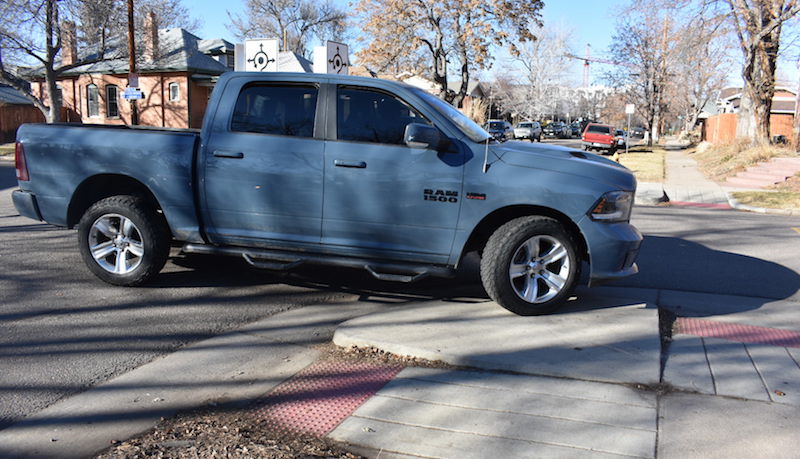
“I strongly feel these are contrary to everyone’s safety, efficiency and economic interests. We asked for none of this,” said Roger Oram, who lives at West 32nd Avenue and Newton Street. “The amount of money that is being spent for these unsolicited so-called improvements would astound most folks.”
In an email responding to Oram’s concerns in 2018, Senior City Planner Dan Raine said, “The current costs of improvements are estimated at about $800,000 for the entire corridor.” Kuhn said that number includes design, but the construction of the traffic circles was only about $13,000 for all three, and the bikeway cost is $300,00 not including the traffic circles. Oram argues he’d rather see the city spending that kind of money fixing alleyways or any number of other priorities.
Yet, advocates said there is no greater investment than in safety, and that these traffic calming measures are helping connect the community. Anne Spires DeLong has lived at West 35th Avenue and Irving Street for 19 years. She said she’s seen dozens of car accidents and the current traffic flow means parents can’t let their children walk across the street.
“People are speeding down Speer [onto Irving] and use 35th to cross,” Spires DeLong said. She said her family has seen the street as a “Berlin Wall” in the neighborhood, cutting off neighbors from each other, and she believes the new concrete barriers that allow pedestrians and cyclists but not cars to cross will be a big improvement in the neighborhood’s connectivity.
“Not only are we slowing traffic for a bikeway, but that benefits pedestrians in the neighborhood, too,” said Kuhn. She noted that reducing speeds is a critical factor in reducing the severity of crashes. “When you can slow people down even five miles per hour, the odds of getting in a crash or the severity of the crash are reduced. The slowing of vehicles is making things safer for people who are walking.”
Community Outreach
Oram and other neighbors have also complained that there wasn’t enough public outreach and they weren’t aware the traffic circles were going in until they were already there. Kuhn said there was significant public outreach associated with Denver Moves Bicycles planning, and a multi-year public process about the West 35th Avenue corridor in 2015. That process is outlined here and included engagement with Highland United Neighbors, Inc., the West Highland Neighborhood Association, and an open house.
There was also a March 2017 open house on final design plans for the bikeway and presentations at neighborhood association meetings. The city also notified residents who had participated in design meetings by email before the traffic circles were installed.
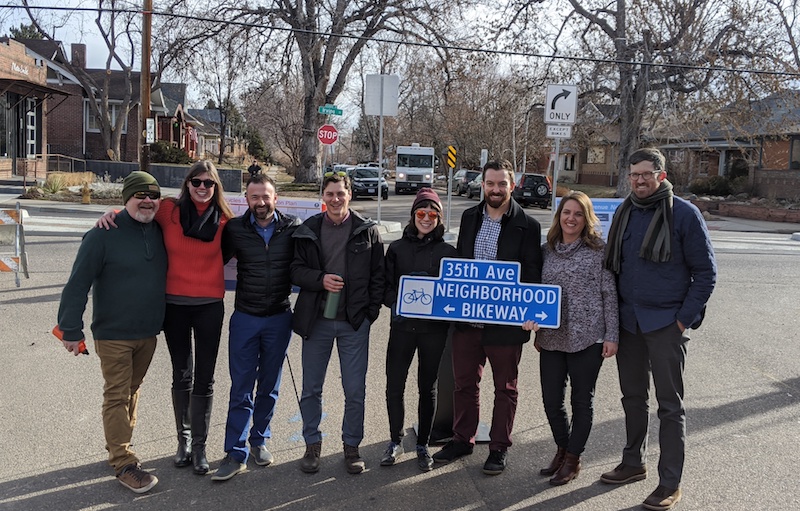
“The first open house I attended for the 35th Ave Neighborhood Bikeway was Sept. 1, 2015, so, yes, I believe the community has been given adequate notice regarding this process,” District 1 City Councilwoman Amanda Sandoval said. “But the project stalled for years and no communication was given to the neighborhood during this time, which was beyond frustrating.”
She said she supports the creation of safer bike infrastructure and multi-modal projects like the West 35th Avenue bikeway. “My hope is that in the future the Department of Transportation and Infrastructure (DOTI) – formally known as Public Works – maintains the lines of communication with the neighborhoods and residents they impact. I will continue to push DOTI to have public meetings and gather as much feedback from residents. It is essential [that the] community is considered and their comments are weaved into the project.”
Kuhn also added that the city set up a phone line for resident feedback and did a survey before and after installation of the circles. Results of that survey are here. It references 68 people responding to the “before” survey and 125 people responding to the “after” survey. The city’s report notes that survey respondents were self-selecting and are not necessarily representative of the neighborhood.
Of the survey respondents, 48% noted they were more comfortable riding bikes on the street after the roundabouts were installed, but 27% said they were less comfortable, and 25% said there was no noticeable change. The city’s report says: “The percent of drivers and pedestrians feeling safe markedly decreased after the traffic circles were installed. This decrease in perception of safety may be attributed to unfamiliarity with the traffic circle as the ‘after’ data was collected only after one month of installation.”
“Whenever you are doing something new, it’s difficult for people to adjust to change,” Kuhn said. “And there are some people who are not bought into the idea of a bikeway and having spaces for people on bikes. No matter what we do there, they may not like it.” She said that it’s helpful when residents can provide specific feedback based on technical merit about the design and “not just ‘I don’t like it.’”
Truck Access
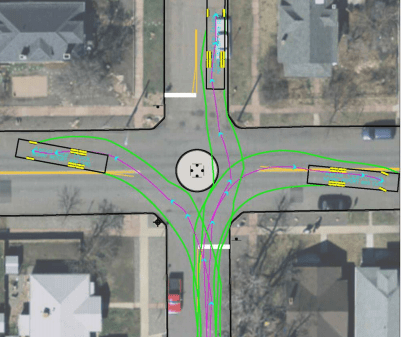
One such technical criticism some neighbors have raised is the inability of fire trucks and other large trucks, like trash and recycling trucks, to navigate the traffic circles.
City Traffic Engineer Emily Gloeckner said that, in reality, fire trucks would just drive over the rubber curbs currently installed if they were responding to an emergency. “In a permanent installation, we would lay out a rollover curb for larger vehicles to navigate the space,” she said. Kuhn noted that the department did coordinate with other agencies, such as the Denver Fire Department, to ensure emergency vehicles could still access the corridor.
Kuhn provided a study the city conducted that shows the turning radius of different sized vehicles. “We found larger trucks would have the room they needed to navigate down 35th Avenue, but highlighted the potential for trucks to have difficulty with the left turn movement,” she said. “We have said that if we see large trucks having trouble making left turns, we will install additional signage prohibiting left turns for larger trucks.”
The Denver North Star photographed multiple drivers that found the circles difficult to navigate even in average-sized pickup trucks.
Watch for updates to this story after the city conducts a new speed study in the spring.

Vision Zero
I can’t say how profoundly disappointed I am in this Hancock Opens Bikeway/Traffic Circles Raise Tensions Around New Bike Path feature story. The newspaper version gives a predominantly Mayor’s-Office promotional version of the bike path improvements which it has forced upon the neighborhood. And the on-line version, which I suspect will not get as many views, is barely better.
The second paragraph in the newsprint edition particularly misstates the facts and misinforms regarding neighborhood sentiments, i.e.:
New traffic calming measures that make the route friendlier to cyclists make it less convenient for cars. While neighbors and bike advocates are celebrating the new route, some neighbors are raising concerns that traffic circles and other traffic calming measures don’t actually slow traffic and may be making the streets less safe instead of more.
Traffic Circles “friendlier” to cyclists? This is a matter of opinion.
Especially what should have been said here is that only 18% of the 163 neighborhood respondents to the City’s phone-in comment log – running for over a year’s time – were favorably inclined toward the Bikeway traffic circles, which were falsely promoted as a speed-reducing-safety measure. For this, I wouldn’t say that the neighborhood has been celebrating very much. Instead it would have been accurate to say that a large majority of neighborhood respondents have been very much against them. For anyone who cares to have a copy of the log (which I supplied to The Denver North Star) send me an email at SignsBeGone@hotmail.com.
Did the City bother itself to ask the neighbors surrounding the traffic circles or the concrete barrier at 35th and Irving what they thought about these ideas?
What the City spends for these Bikeway “improvements” is, I believe, a complete waste of money. How is it that so much money can be spent on such ill-considered and ill-received projects when there are so many other dire needs in Denver?
Meanwhile, the Hancock Vision Zero, anti-car, pro-congestion administration* has ignored the neighborhood sentiments, just as it has in traffic light removals on 32nd Avenue. *https://www.denverpost.com/2020/02/11/guest-commentary-denver-is-waging-a-war-on-cars-and-drivers/
For those readers still interested, please also see the e-mails below (which I also sent and forwarded to the newspaper). They demonstrate the City’s wrong-headed and intractable Bikeway decisions, which we may be burdened with for years to come.
This document will also be forwarded to SignsBeGone@googlegroups.com and may also be utilized as a reference for Next Door comments. I ask that The Denver North Star may publish the entirety of this letter on line and may publish sections of it subject to my approval in print. If letters to the editor will be printed on this issue, I would like to participate in the discussion.
Roger Oram
From: SignsBeGone@hotmail.com
Tue 1/14/2020 11:16 PM
Hi Sabrina and David,
Here is the link to Denver Public Works West 35th Ave. Traffic Circle Summary Report, which apparently was published in November of 2018, which I believe was long before the survey signs came down.
https://www.denvergov.org/content/dam/denvergov/Portals/708/documents/NBW/NBW-traffic-study-evaulation-2018.pdf
West 35th Avenue – Denver
the first month of operation, which is a limited time frame for travel behavior and perceptions to fully normalize. The evaluation is based on both
http://www.denvergov.org
Given the speed statistics, I would say that the circles prove themselves ineffective. And I am very suspicious about the “Safety and Comfort” statistics – with whom, where, and how these were generated. I trust none of these “results” and I feel that they were probably generated by contacting supporters of their 35th Ave. Neighborhood Bikeway plan, which they promoted before installing the traffic circles. They have largely ignored the neighbors themselves.
I do not think that the survey-sign/phone-in results have been reported in this misleading document.
As far as I know, there was no neighborhood feed back on this or any other survey results whatsoever. When it was published, I had written my complaints about them to both Dan Raine and Eulois Cleckley. My remarks have been disregarded and there are many others in the neighborhood who have also complained very strongly. We feel marginalized by way their experimental-then-permanent traffic plans have been foisted upon us. The report shows a great deafness to listening to neighborhood concerns.
The accident records do not support experimenting with traffic circles or any other expensive traffic-calming annoyance at Julian, Newton, and Raleigh. And as far as inclusion for a proposed “neighborhood bikeway,” they are very dangerous to all modes of travel, but perhaps especially to bicyclists and pedestrians.
Previously, I made a suggestion to challenge large vehicles, including fire trucks to make left-hand turns around the circles. I read here on page 2 of the “Summary” that Denver Fire Department vehicles have been exempted! Also, if Traffic and Mobility personnel are so enamored with Seattle (or Boulder) traffic-calming tactics, I invite them to all find jobs there.
Please still invite any and all large vehicles to traverse the West 35th Ave. circles. It would be interesting to see how quickly and cleanly even a full-sized fire truck could shortcut the circle.
To settle how the neighborhood feels about these traffic circles, I would also suggest conducting a Denver North Star neighborhood poll, which would allow only one vote per Highlands constituent, verifying ID and residency.
Thank you for your time and attention.
Roger Oram
From: Raine, Dan W. – PW Senior City Planner
Sent: Wednesday, November 28, 2018 1:47 PM
To: Roger Oram ; Cleckley, Eulois – PW HA1419 Manager Department of Public Works
Cc: District 1 Comments ; Sandoval, Amanda P. – DFD CA1714 Program Manager ; SignsBeGone@googlegroups.com ; Fry, Logan M. – CC YA2957 Executive Assistant I ; Jackie Youngblood ; Trevor Greco
Subject: RE: 35th Avenue Bicycle Study and Traffic Circles
Hi Roger,
Thank you for your note and for sharing your opinions. In reference to the project costs, an initial planning-level estimate for the project was developed in 2015. The designs provide an estimate for the construction of the project, these costs include mobilization of the construction team, methods for handling traffic, material costs and delivery, as well as many more details that involved in construction. It is likely that inflation could be involved in the cost of service and materials as well. There are no cost estimates for permanent traffic circles at this time as a design has not been initiated. We are currently wrapping up our initial evaluation of these traffic circles and will not initiate a design until we learn of their effectiveness. We have hired AECOM to design the improvements planned for the W. 35th Neighborhood Bikeway, which included survey and design work, documentation and public engagement. Their fees for this effort are at about $175,000.00. There was a traffic signal at the intersection of W. 35th Avenue and Irving, but it was removed many years ago. Unfortunately, I do not have a specific breakdown in costs for the refuge island planned for W 35th Ave at Irving.
Kind regards,
Dan
Dan Raine AICP LCI | Senior City Planner
Transportation & Mobility | Denver Public Works | City and County of Denver
720.865.2660 Phone
dan.raine@denvergov.org
Follow Denver Public Works on Facebook and Twitter
From: Roger Oram [mailto:SignsBegone@hotmail.com]
Sent: Thursday, November 08, 2018 11:51 PM
To: Raine, Dan W. – PW Senior City Planner ; Cleckley, Eulois – PW HA1419 Manager Department of Public Works
Cc: District 1 Comments ; Sandoval, Amanda P. – DFD CA1714 Program Manager ; SignsBeGone@googlegroups.com; Fry, Logan M. – CC YA2957 Executive Assistant I ; Jackie Youngblood ; Trevor Greco ; Schmitz, Justin A. – PW Engineer And Architect Supv ; jeff.martinez@denvergov.org
Subject: [EXTERNAL] Re: 35th Avenue Bicycle Study and Traffic Circles
Use caution with attachments or links.
________________________________________
Hello Mr. Raine,
Thank you for your considerate reply and the answers to many of the questions I posed.
Is it now in fact $800,000 (up from $424,325) allotted for the 35th Avenue Bikeway “improvements”? Is this due merely to inflation, or have there been modifications to the original proposal?
How much now for Zone 2 and where would most of the money be spent? On “permanent” traffic circles – after $13,000 has already been spent on the three temporary Traffic Study circles?
I have learned at the WHNA meeting on Tuesday that Traffic and Mobility contracts for traffic designs from private companies? Was a traffic design company engaged for this Bikeway project? If so, what company and how much has the City committed to pay for this design work?
How much would the 35th and Irving refuge island cost? Was there a stop light at 35th and Irving before it was converted back to two-way traffic? If the price tag is $500,000 for installing one stoplight, it is plain that entirely removing stop lights is not a good idea, including those at 35th and Tennyson and at 32nd and Perry and Tennyson.
In my opinion, it is benighted to believe that removing the stoplights at the latter intersections, building 3 or 4 bulb outs along 32nd Avenue, and a pedestrian flashing-light crossing at Julian, all creating more congestion, while at the same time trying to reduce auto traffic on 35th Avenue, will will make the number of automobiles traveling through and in our neighborhood diminish.
And the negative consequences that these ill-conceived changes could bring may become starkly evident to everyone if they are allowed to proceed.
Thanks again for your attention and consideration to concerns that I and many of my neighbors feel have been marginalized.
Roger Oram
________________________________________
From: Raine, Dan W. – PW Senior City Planner
Sent: Wednesday, November 7, 2018 8:57 AM
To: Roger Oram; Cleckley, Eulois – PW HA1419 Manager Department of Public Works
Cc: District 1 Comments; Sandoval, Amanda P. – DFD CA1714 Program Manager; SignsBeGone@googlegroups.com
Subject: RE: 35th Avenue Bicycle Study and Traffic Circles
Hello Mr. Oram:
Thanks for your note. W. 35th Avenue is a popular cycling route that links HUNI and WHNA with Downtown Denver. It was identified as a potential Neighborhood Bikeway as part of the Denver Moves bicycle plan and studied in 2015. The current costs of improvements are estimated at about $800,000 for the entire corridor. Thank you for your comments regarding curb extensions adjacent to the school, these will be paint (only), not concrete, as to allow a visual narrowing of the intersection that can benefit pedestrians while not impacting bicyclists. There are no plans for similar improvements along 33rd Avenue. The implementation of the W 35th Avenue Neighborhood Bikeway project are using funds dedicated to bikeways. We are currently evaluating the effectiveness of traffic circles and a report will be available before the end of 2018. Thank you for your comments and observations of the traffic circles, we have received many from the community that also share their thoughts and concerns. We are learning a lot from this effort.
For the traffic circle evaluation project, we did receive the support of the Denver Fire Department and developed the truck turning templates for large trucks and emergency vehicles. This documentation will be included in the report. At the time of the 2015 study, there were no reported crashes at the intersection of W 35th Avenue at Newton. Thank you for your comments regarding are proposed improvements at the intersection of W. 35th Avenue at Irving. With a traffic signal at W 34th and Irving, the project team proposed that creating a pedestrian and bicyclist refuge island, while restricting left turns at this location, would (1) have the potential to reduce crashes at this location and (2) provide a low cost, improved crossing of Irving for people walking and cycling that would not require a new traffic signal (which can cost up to $500,000). Thank you for your comments regarding the photos used in the report. While those photos were depicting similar-type bikeways (in use) in peer cities, we recognize your concerns and will not use similar photos in the future.
Kind regards,
Dan
Dan Raine AICP LCI | Senior City Planner
Transportation & Mobility | Denver Public Works | City and County of Denver
720.865.2660 Phone
dan.raine@denvergov.org
Follow Denver Public Works on Facebook and Twitter
From: Roger Oram [mailto:SignsBegone@hotmail.com]
Sent: Monday, October 29, 2018 12:30 AM
To: Raine, Dan W. – PW Senior City Planner ; Cleckley, Eulois – PW HA1419 Manager Department of Public Works
Cc: District 1 Comments ; Sandoval, Amanda P. – CC Senior City Council Aide ; SignsBeGone@googlegroups.com
Subject: [EXTERNAL] 35th Avenue Bicycle Study and Traffic Circles
Use caution with attachments or links.
________________________________________
Mr. Raine,
I have read the 35th Avenue Bicycle study, published in September 2015. That is:
https://www.denvergov.org/content/dam/denvergov/Portals/708/documents/NBW/W35th-NBW-Study-Final-Report.pdf
Here are my questions, observations, objections, and suggestions:
• Did HUNA or WHNA from our neighborhood request the “W35th-NBW-Study”? If not, who did?
• What is the current cost estimate for all of the 35th Avenue “Improvements” which in 2015 were projected to be $474,325?
• Does Zone 2 truly get nearly half of the entire amount, i.e. $231,850? – Is this allotment mostly for pedestrian-intended curb extensions around Edison school? Why are these “improvements” added in a Bikeway Feasibility Study? (I would argue that these pose greater danger to bicyclists.) Do you plan on constructing these on 33rd as well? I think that none of these intersections qualify for any expensive road-narrowing expenditure.
• Did taxpayers in Denver approve this specific Bikeway project appropriation for 35th Avenue?
o If this money has no earmarks, why not spend it on repairing the neglected concrete alleys in our neighborhood? (Our concrete alley has a forlorn double layer of receding and crumbling blacktop on it that previous quick-fix Public Works administrations applied – please remove thank you!)
• How do traffic circles improve traffic safety for bicyclists and pedestrians? Especially here, they have been promoted as a solution to problems that I contend do not exist. Contrary to “traffic-calming” handbook assertions, I would say that traffic circles are not safer to pedestrians or bicyclists either. Since the circles were installed in August, there have been at least two recorded instances at Raleigh from pedestrians who have had close calls to being struck by automobiles.
• Both bicyclists and large trucks have been observed turning left, short-cutting the traffic circle.
• How will fire trucks negotiate these traffic circles? Was Emergency Services consulted before installing them? If so, who approved them?
• What is the accident record for 35th and Newton? (The Study has omitted this intersection.)
• Your Study also indicates that you plan to eliminate a left turning lane in each direction on busy Irving at 35th. At this intersection, there probably was a traffic light with pedestrian walk buttons at one time. Why not provide a stop light here again – perhaps move the one now at 34th to 35th? Does the cost of this diverter and the marginal safety benefits to bicyclists and pedestrians warrant a barrier to turn left for automobiles between 38th Avenue and Speer Blvd????
• Furthermore, I do not believe that your 35th Avenue bicycle plan met sufficient approval from our community. Two neighborhood group presentations and a bicycle shop easel-poster show do not provide enough neighborhood input to implement any substantive changes, including the “temporary” traffic circles. What residents from NW Denver were on the Committee that authored this Study? Was there fair representation of those who happen to like the streets as they have been?
• Lastly, the bicyclist photos shown in this Study do portray very poor bicyclist behavior. Four photos show bicyclists with dogs leashed to them, or young families gaily riding side-by-side in the middle of fully parked-up city streets. I have seen neither very often. If these people like traffic circles and other traffic-flow inhibiting devices, please invite them to reside somewhere in suburbia where they can live their irresponsible lives.
• My suggestions:
o Immediately remove the traffic circles. The accident records show no need for them. If motorized speed control is your principal concern, post several permanent speed limit signs with speed monitoring devices along 35th Avenue that flash when autos exceed the posted limit.
o Discontinue implementing any more of the W35th-NBW-Study recommendations. The cloistered group that has generated this Study on behalf of the Mayor’s office does not represent the vast majority of sentiment against such wasteful, ugly, infuriating, and sometimes dangerous modifications to “calm” traffic in our neighborhood.
o Remove the east-west stop signs at Julian (and any others en route) so that bicyclists and automobiles on 35th won’t have to hesitate at this intersection. As you should know, the MUTCD Traffic Manual says that 4-way stops should not be employed for speed control. (And postulating from my research elsewhere, the number of accidents at this intersection may never have really warranted installing yet another 4-way stop….?)
Thank you.
Roger Oram
The traffic circles do not slow down traffic. The traffic circles, by the city’s own admission, require large trucks to break the law and turn left in front of the circle. The traffic circles do not follow standard traffic circle protocol. There must be four crosswalks for pedestrians. Pedestrians must have the right of way over all other traffic. There must be four yield signs. The city has decided to make up its own protocol that is not compliant with the world’s eye view of traffic circles. The traffic circles do not add anything useful. Drivers use them to make dangerous U-Turns in intersections while ignoring pedestrians.
I agree with the fact that it’s difficult to make a change when something new happens, like a roundabout being installed. I think that over time, people will realize that it’s helping everyone. Once people get in the habit of watching for bikers I’d assume the bikers would feel safer. I know that sometimes pedestrians are the last thing on my mind at a roundabout, but if there are good signs and cross walks it should be pretty safe. Hopefully people adjust to this and it continues to work!